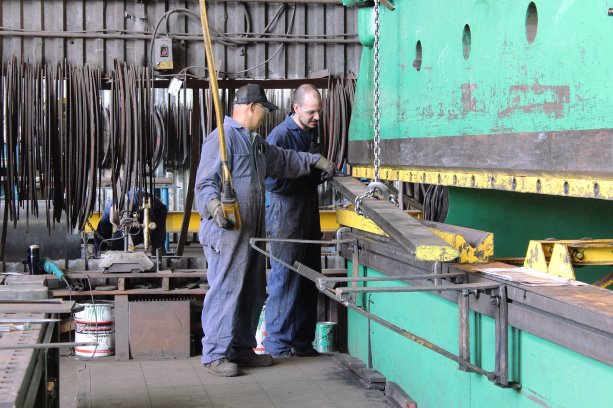In 1909 George Third emigrated from Aberdeen, Scotland to Brandon, Man.
Just weeks later he took a train to Vancouver to escape Manitoba’s harsh winters.
He got off the train at Main Street, walked across the street to a blacksmith shop, said he was a journeyman blacksmith from Scotland and needed a job. The 25-year-old was told he could start right away.
"He bought that company a year later in 1910 for $50 and that was the start of George Third & Son," said Rob Third, George’s grandson who now runs the business.
The company has come a long way from making horseshoes and wagon wheels. The Burnaby, B.C.-based fabricator has worked on Rogers Arena, CenturyLink Field, skyscrapers in San Francisco and makes parts for the U.S. Navy. He pointed out some of the current projects they are working on as he ushered tour groups through the facility on SteelDay, which took place at various locations across the country on Sept. 16.
The business shows no signs of getting outside the Third family. Rob Third said his son is now his partner in the business and will keep the family tradition going strong.
"People like that lineage and history of doing the job right," Third said. "There is no corporate entity anywhere else. The buck stops here."
Third started working in the business in his 20s after training as a graphic designer and he has seen the landscape change.
"The industry is a lot more complex than it used to be," he said.
The buildings are more complex and going from drawings to fabrication can take months of back and forth.
Third has also seen loyalty fade away, he said. Coming up in the industry with his father, some general contractors would only use George Third & Son steel and weathered price changes with them.
"Now it is much more cutthroat and the low price wins," Third said. "You have to be low or you don’t get the job. There are lots of Asian fabricators that could blow us out of the water with great work but you have to know who you are dealing with and that low price is not necessarily the right price." Third explained that it is very tough for Canadians to compete with foreign steel producers on what he said isn’t a level playing field.
And the federal government is currently investigating whether fabricated industrial steel components from China, South Korea, Spain, the United Arab Emirates and the United Kingdom are being sold at unfair prices into Canada. It will also investigate whether subsidies are being applied to fabricated industrial steel components from China in contravention of the Special Import Measures Act.
This year Canadian steel producers also complained about the dumping of hot-rolled deformed steel concrete reinforcing bar in straight lengths or coils from Belarus, Chinese Taipei, Hong Kong, Japan, Portugal and Spain.
China and South Korea have been the subject of several Canada Border Service Agency (CBSA) investigations.
And while the CBSA continues to investigate, Third said he is still frustrated with provincial governments that use taxpayer money for infrastructure projects to hire foreign companies to do the work.
"How does that do anything for the Canadian economy?" he said.
The company recently bid a job in Stewart, B.C. for a deep sea port. They were the lowest bid from a Canadian fabricator and it was given to a Chinese fabricator.
"I was told they were about half what our price was," Third said, adding he was frustrated to see local politicians touting the new foreign-built dock at a ribbon cutting ceremony.
Third said the steel industry in Vancouver has shrunk over the past 25 years.
"That’s not because they aren’t building as much stuff out of steel," he said. "It’s just coming from other places. I am not looking to expand my business. If anything I am looking at finding a smaller place for me to do business."
As for the future of steel, Third said it isn’t looking rosy, in part because of the economic slump oil prices have brought to Alberta.
"I think it looks a bit quiet," he explained. "A lot of the steel fabrication capacity in this country has been building stuff for the tar sands and the biggest fabricators are in Alberta in Quebec and those guys are now looking for projects everywhere else. I think we are going to have an over capacity, so there will be some issues with that."

1/2
Workers change moulds that shape pieces of steel at Burnaby-based steel fabricator George Third & Son. On SteelDay, Sept. 16, the company along with many others invited visitors into its shop to see how Canadian steel products are made.
Photo: Russell Hixson
2/2
A load of fabricated steel products are prepared for shipment at George Third & Son. Visitors got a tour of the facility during SteelDay.
Photo: Russell Hixson"


Recent Comments
comments for this post are closed